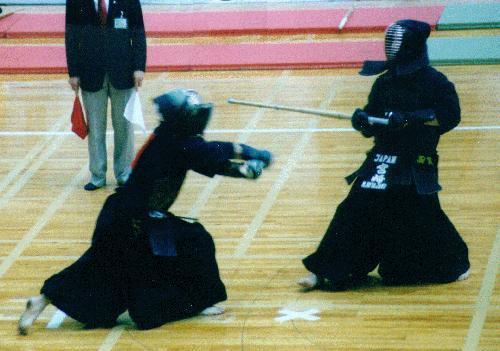
KENDO The Way of the Sword
|
Kendo is the art of Japanese fencing and dates back nearly two-hundred years. The sword was the weapon of choice in Japan for over a thousand years. About two hundred years ago the Japanese created a form of fencing that eliminated the risk involved with the use of real swords. "The aim of kendo, and of all japanese martial arts, is not the perfection of a physical technique but the development of a flowing, flexible mind - a mind that is able to react to anything it confronts, instinctively, fearlessly, and without hesitation, reguardless of the situation. Kendo is broken down into three parts: kihon (basics), Keiko (practice), and Kata (forms)." -- Sensei Darrell Craig |
THE BASICS
The object of kendo is to score points during matches, much like European fencing. Points are scored when a hit is made on an opponent's head, wrist or torso. Unlike European fencing, however, kendo scoring requires the attacker to have perfect footwork, a strong yell (the kiai) and follow-through (zanshin). Without these three elements in unison, judges will not award a point. A match goes for three minutes or until one opponent scores 2 points. The equipment used for kendo practice are the bamboo sword (Shinai) and a set of protective armor (Bogu).

The shinai is approximately four feet in length and is made of four staves or pieces of bamboo that are fitted and held together at both ends by a leather handle, tip, and special string designed to designate the back of the sword. To make a valid cut a player must strike his opponent with the side opposite the cord. In addition the point must be struck with the top third of the shinai. The shinai itself is not a point area, but to knock aside or to brush off an opponent's shinai is an important part of technique. Consider the shinai a real sword and treat it with respect. Do not step over the shinai or lean on it.
| The Bogu consists of four different parts: Men, Do, Tare, and a pair of Kote. Men is the helmet which protects the face, throat, top and sides of the head. Do is similar to a breastplate and covers the chest and stomach. Tare is the waste protector. Finally, Kote are like gauntlets and protect the hands and wrists. The Bogu is worn over a Hakama (traditional Japanese clothing) |  |
In Kendo, there are four general areas to attack, subdivided into left and right sides of the body - each worth one point. These are strokes to the head, the wrist, torso, and a thrust to the throat. In order to be considered successful, the attack is to be a coordination of the spirit, proper usage of the sword, and correct movement of the body so that it would be a clear and proper stroke, as if it were made with a real sword.
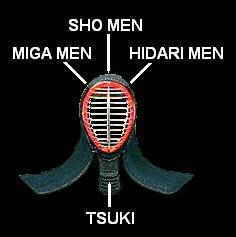 |
The part above the temple of the head is considered as a point area. Generally Men is subdivided into three parts: Sho-men (center), Migi-men (right), and Hidari-men (left). Tsuki is the throat area. Unlike other point areas, this is the only one where the point is made by poking rather than by hitting. Scoring Tsuki is allowed only for Dan players (black belts), since it requires sophisticated techniques in order to score properly. |
| Do is subdivided into Migi-do (right) and Hidari-do (left). In general, Do means the right one (i.e. the right side of the opponent). The left Do is often described as Gyaku-do, which means the opposite Do. In olden times, Samurai wore swords on the left side so it was difficult to cut that side, since the swords could obstruct the blow. Therefore, in order to score on the left Do, the stroke has to be especially precise. | 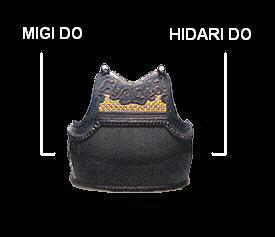 |
Kote is subdivided into Migi-kote (right) and Hidari-kote (left). In general, Kote means the right one (i.e. the right wriste of the opponent). However, the left one is also considered as a valid point area if the opponent takes an alternate posture in which the left hand is in front.
THE PRACTICE
A Kendo examination is different from a match and is not a competition for points. An examination is evaluated based on one's general ability. The major criteria are:
Hit at ideal opportunities. Aggressive attacking
THE KATA The Kendo Kata are carried out by two kendoist working together in harmony, the Shidachi (student) and the Uchi-Dachi (teacher), equiped with wooden boken (or in the case of high level practitioners with a metal blade) katana (long sword) and wearing no armor. The Kata act as a living library of the basic sword techniques and consist of kata with katana against katana, or with katana against wakizashi (short sword). In each of the Kata the Uchi-Dachi acts as the aggressor and strikes with the katana, to which Shi-Dachi respondes with whichever sword they are equipped with. There art thousands of kendo Kata developed by various sword schools over the centuries. "The kendoist who can achieve total unity of mind, sword, and body has truly achieved mastery. When practicing kendo or kendo kata, you must strive to have these three elements in combination. Using one or two without the other will result in poor swordsmanship and poor kata." -- Sensei Darrell Craig
Repetitive practice in the basics of kendo is the foundation for expanding knowledge and skill. Kendo success is achieved through physical effort, mental discipline and honest self-examination. Continuous training in kendo is rewarded with respect for ourselves, opponents and others. Kendo is one art that can be started at any age level and expand to a spirit of self improvement. Kendo practice consists of several different exercises. Each exercise is designed to improve different aspects of strength and skill required in Kendo. For beginners, the repetitive practice of basic movements is stressed in order to acquire the ability of moving without thinking. A Kendoist must learn to counter an attack instantaneously whenever the opponent moves. As one progresses, more spiritual understanding is sought through continuous practice in order to be in control of any kind of situation.
An adjunct to practice is the examination for rank.
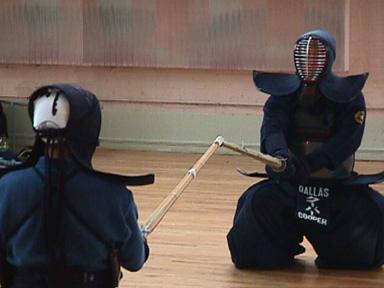
KENDO PRACTICE
"The dojo does not exist solely for the purpose of mastering the sword but also to hand down knowledge. True knowledge of kendo, like skill, cannot be taught; it can be acquired only through long hours of practice and training." -- Sensei Darrell Craig The Heart of Kendo.
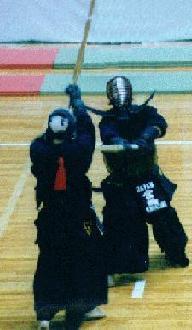
Adhere to proper basic Kendo.
Proper posture should be maintained at all times. Bending of waist, bending of neck, raising the left hand for defense will reflect poorly your evaluation. One should use footwork and one's Shinai to manage opponent's attack, thus allowing you to maintain proper posture.
Not hitting at the ideal opportunities, such as the beginning of the opponent's action or the beginning of the opponent's backward movement will most likely result in an incomplete attack. The more one hits incomplete points, the less likely one's chance will be of passing. One should strive not to hit incomplete points, and focus on hitting points that count.
The roots of Kendo is based on combat. Therefore, you should show willingness to attack with your full ability. Even if one does hit the point, if one is spiritually weaker than one's opponent and/or is not fighting aggressively, the hit will not be a point. If one strongly feels like attacking from within oneself, one should not worry even if one gets hit. Having the spiritual intention you must attack without withholding anything (i.e. spirit, energy, speed, and et cetera).
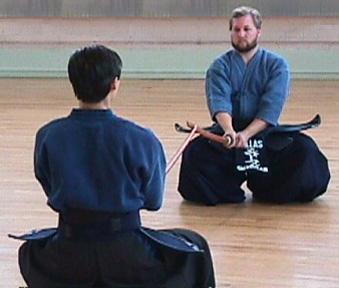
KENDO KATA
